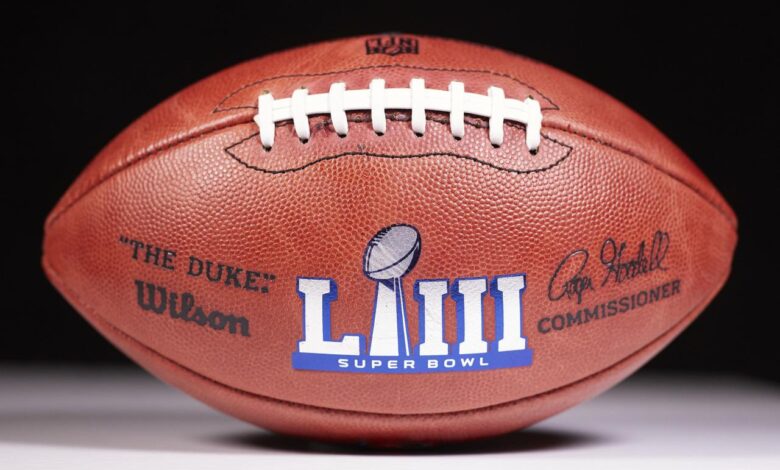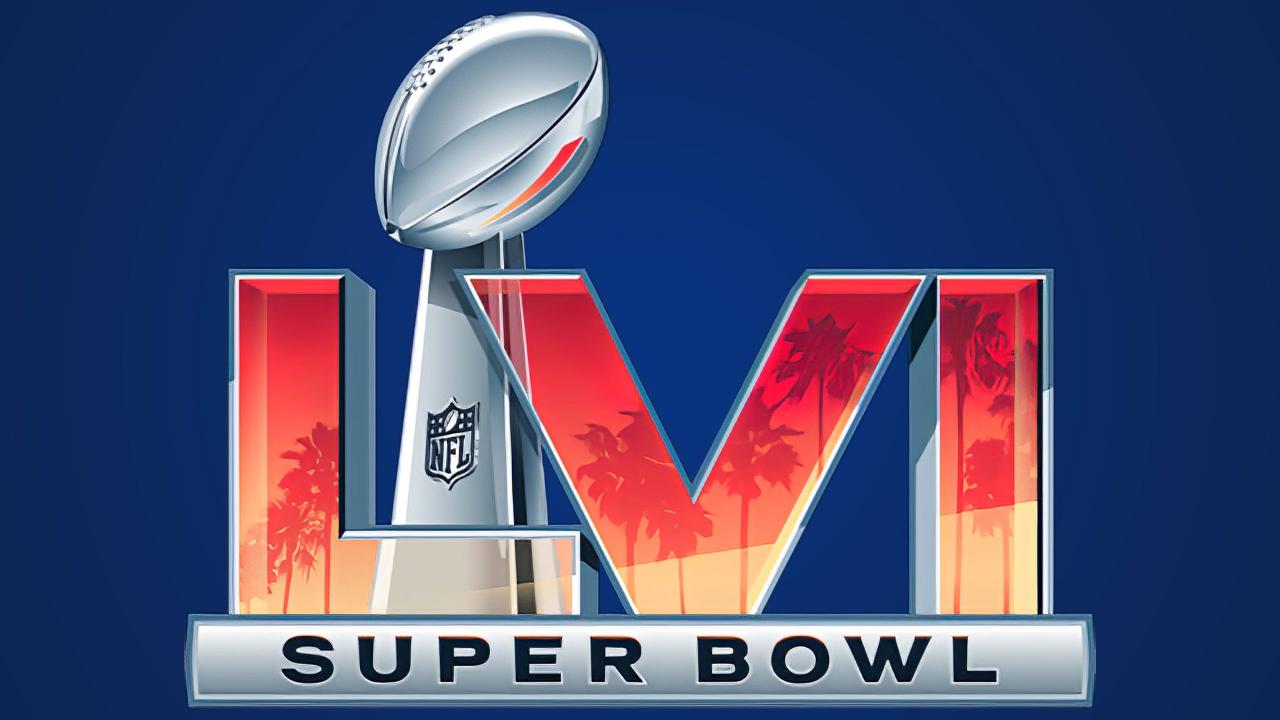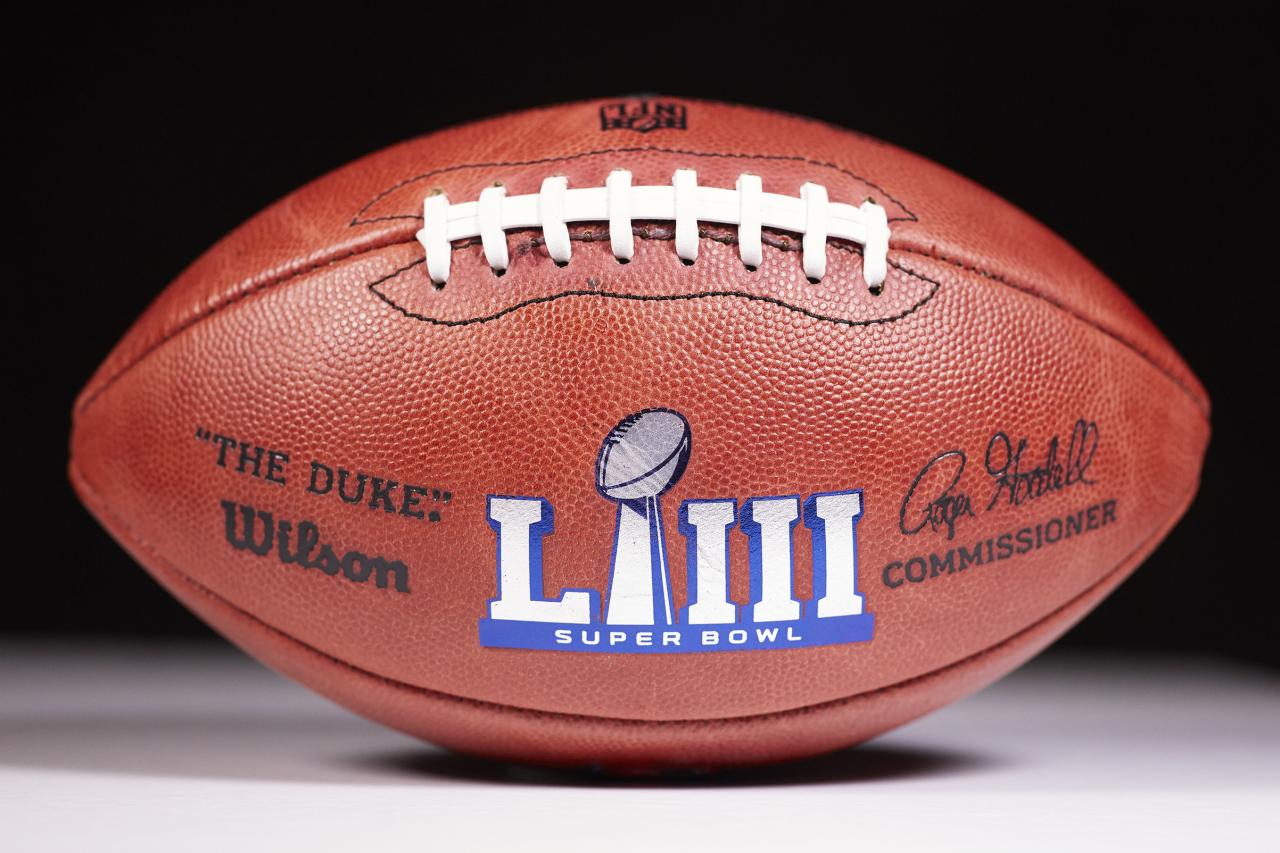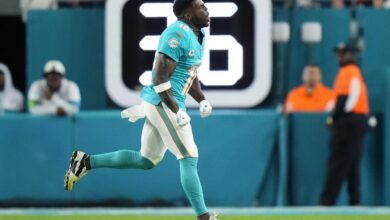
Super Bowl NFL Football A Deep Dive
Super Bowl NFL Football, the pinnacle of American football, is more than just a game; it’s a cultural phenomenon. From its humble beginnings to its global reach, the Super Bowl has evolved alongside American society, reflecting shifting values and trends. This in-depth look explores the history, teams, commercials, impact, predictions, fan culture, and global viewership of this iconic event.
This comprehensive exploration delves into the rich tapestry of the Super Bowl, examining its various facets, from the strategic battles on the field to the captivating entertainment and commercials that dominate the pre-game and halftime shows. We’ll uncover the stories behind the winning teams, the legendary players, and the enduring impact of this spectacular event on society and the global sports landscape.
Super Bowl History and Evolution
The Super Bowl, the culmination of the National Football League (NFL) season, is more than just a football game; it’s a cultural phenomenon. From its humble beginnings as a championship game, it has evolved into a global spectacle, reflecting societal shifts and economic trends. This journey of transformation is mirrored in its rules, marketing strategies, and the demographics of its audience.The Super Bowl’s enduring popularity stems from its ability to adapt to changing times while retaining its core appeal: the ultimate test of NFL prowess.
This evolution, from its early years to the modern-day spectacle, is a fascinating story, revealing the dynamic interplay between sports, entertainment, and societal values.
Chronological Account of Super Bowl Games
The Super Bowl’s history provides a fascinating lens through which to view American culture’s evolution. Each game reflects the socio-political climate of its time, the evolving strengths of different teams, and the growth of the sport itself.
| Year | Winning Team | Losing Team | Key Highlights |
|---|---|---|---|
| 1967 | Green Bay Packers | Kansas City Chiefs | First Super Bowl, marking the beginning of a new era in American sports. |
| 1968 | Green Bay Packers | Oakland Raiders | Packers’ second Super Bowl victory, solidifying their dominance in the early years. |
| 1969 | New York Jets | Baltimore Colts | A surprising victory for the Jets, highlighting the unpredictable nature of the NFL. |
| 1970 | Kansas City Chiefs | Minnesota Vikings | The beginning of the NFL’s expansion and the emergence of new teams. |
Evolution of Super Bowl Rules and Formats
The Super Bowl, while retaining the fundamental principles of football, has seen adjustments in its rules and formats over time. These adjustments have reflected both the needs of the game and the changing landscape of professional sports.
Super Bowl NFL football is a massive event, and with the excitement comes a lot of speculation about the lavish lifestyles of players. Thinking about the incredible wealth, it’s fascinating to consider homes in California, like those costing around $800,000. 800000 dollar homes california often boast stunning views and unique architectural designs, and it’s a whole different kind of thrill compared to the thrill of the game itself.
Still, the real star of the show is always the Super Bowl.
- Early rule adjustments focused on standardizing gameplay, ensuring fairness, and improving the overall flow of the game. For instance, the introduction of specific rules regarding holding or unnecessary roughness, improved the level of competition, allowing for a more exciting spectacle.
- The introduction of new technologies, like instant replay, has significantly impacted the game’s evolution. The ability to review questionable calls has led to a greater emphasis on accuracy and fairness in decision-making.
- Modifications to overtime procedures have evolved to reflect a greater emphasis on strategic decision-making, ensuring a clear victor in situations where the regular game ends in a tie. This has been especially important in recent decades as teams have become more evenly matched.
Shifting Demographics and Fan Bases
The Super Bowl’s audience has expanded significantly over time, reflecting shifts in American society and the global reach of professional sports.
- Early viewership was largely concentrated in the United States. However, the rise of international broadcasting and the increasing popularity of the sport internationally has broadened the fan base, bringing in fans from different cultural backgrounds and economic statuses.
- The demographics of viewers have changed. In the early days, the Super Bowl drew a predominantly male audience. Over time, the audience has become more diverse, encompassing a wider range of ages, genders, and ethnicities. This evolution mirrors the broader social changes in America.
- The impact of social media and digital platforms has had a profound effect on the way people engage with the Super Bowl. The ability to connect with others, share experiences, and form online communities has fostered a deeper level of engagement among fans. This trend is also reflected in how advertisers target their campaigns.
Evolution of Super Bowl Marketing and Branding Strategies
The Super Bowl has become synonymous with advertising innovation, impacting the marketing strategies of major brands worldwide.
- Early Super Bowl commercials were largely straightforward, focusing on product features and benefits. As the game gained popularity, the commercials evolved to include more creative and elaborate narratives, tapping into broader cultural trends.
- The increasing cost of advertising during the Super Bowl has pushed advertisers to become more creative and innovative in their campaigns. The high stakes involved have spurred them to produce commercials that are memorable, engaging, and impactful. This has resulted in the development of innovative strategies that aim to maximize their impact on viewers.
- The rise of social media has further transformed Super Bowl marketing. Brands now use social media to create pre-game buzz, promote commercials, and engage with fans in real-time. This has created a more interactive and dynamic advertising experience.
Super Bowl Teams and Players

The Super Bowl, the pinnacle of American football, has witnessed a multitude of dominant teams and unforgettable players. From the iconic dynasties to the underdog stories, the competition has shaped the game’s narrative and cemented the legacies of those who have graced the field. Each team’s journey, from the regular season to the championship game, reflects the strategic choices, player performances, and sheer determination that defines the sport.The success of a team isn’t solely dependent on individual talent, but also on the synergistic efforts of the entire roster.
Effective offensive and defensive strategies, coupled with strong coaching, play a crucial role in a team’s overall performance. The evolving nature of the game, from the early days to the present era, has also influenced the strategies employed by different teams.
Most Successful Super Bowl Teams
Historically, the Pittsburgh Steelers and New England Patriots stand out as the most successful franchises in Super Bowl history. Their consistent dominance, marked by multiple championships, reflects their consistent commitment to excellence. Other teams, like the San Francisco 49ers and Dallas Cowboys, have also achieved significant success, but the Steelers and Patriots have consistently emerged at the top.
Super Bowl Sunday is always a huge deal, with millions glued to the TV. But beyond the exciting plays and nail-biting finishes, the discussion often shifts to more nuanced topics. For example, recent debate surrounding President Biden’s age and cognitive abilities, as examined by a neuroscientist in this fascinating piece on neuroscientist on biden age memory , sparks interesting conversation.
Regardless of where you stand on the issue, the Super Bowl remains a thrilling spectacle of athleticism and sportsmanship.
Playing Styles and Strategies of Different Teams
Different teams have adopted varying playing styles and strategies throughout the Super Bowl’s history. The Pittsburgh Steelers, known for their aggressive defense and meticulous offense, have consistently relied on a well-structured, systematic approach. Conversely, the San Francisco 49ers, during their heyday, emphasized a high-powered, dynamic offense featuring innovative plays. Each team’s approach, tailored to their strengths and weaknesses, has contributed to their unique Super Bowl narratives.
Legendary Players and Their Impact
Several players have etched their names in Super Bowl lore. Joe Montana, with his clutch performances, exemplified the impact of a quarterback capable of leading his team to victory in critical moments. Tom Brady’s longevity and record-breaking achievements in the Super Bowl have solidified his position as one of the greatest players of all time. The impact of these players on their respective teams’ success is undeniable, showcasing the importance of exceptional talent in achieving Super Bowl victories.
Key Player Performances and Outcomes
The performance of a key player can significantly influence the outcome of a Super Bowl game. A stellar offensive performance, like a game-winning touchdown pass, can turn the tide of the game. Conversely, a crucial interception or fumble can lead to a devastating loss. The impact of these moments on the overall outcome is undeniable, illustrating the pivotal role of individual player performances.
Top 5 All-Time Leading Rushers in Super Bowl History
| Player Name | Team | Total Yards | Years Played |
|---|---|---|---|
| Walter Payton | Chicago Bears | 1,315 | 1975-1987 |
| Franco Harris | Pittsburgh Steelers | 1,250 | 1972-1981 |
| Emmitt Smith | Dallas Cowboys | 1,125 | 1990-2004 |
| Barry Sanders | Detroit Lions | 994 | 1989-1998 |
| Adrian Peterson | Minnesota Vikings | 944 | 2007-2017 |
This table showcases the top five all-time leading rushers in Super Bowl history, highlighting their contributions to their respective teams. The longevity and impact of these players are evident in their impressive yardage totals and the years they played.
Super Bowl Commercials and Entertainment
The Super Bowl, far beyond a sporting event, is a cultural phenomenon. Millions tune in not just for the game, but for the captivating commercials and electrifying halftime shows. These elements have significantly shaped popular culture, driving trends and influencing consumer choices. The Super Bowl has become a platform for advertisers to showcase their products and for entertainers to captivate audiences, making it a significant economic and entertainment force.The Super Bowl’s unique blend of athleticism, entertainment, and advertising creates an unparalleled opportunity.
This creates a highly anticipated and lucrative market for brands seeking to connect with consumers. The pressure is immense, and the potential rewards for a successful campaign are equally substantial.
Significance of Super Bowl Commercials
Super Bowl commercials hold immense significance in popular culture, acting as a potent medium for product promotion and cultural commentary. Their high visibility and mass audience exposure create an opportunity for advertisers to showcase their products in a memorable way. These commercials often utilize innovative strategies and creative techniques, pushing the boundaries of advertising and influencing future campaigns.
Effectiveness of Different Commercial Strategies
Various strategies are employed in Super Bowl commercials. Humorous approaches, emotional appeals, and celebrity endorsements are commonly used. The effectiveness of each strategy depends on factors like the target audience, the product being advertised, and the overall campaign. For instance, a humorous approach might resonate with a younger audience, while an emotional appeal might connect with consumers on a deeper level.
Super Bowl NFL football is always a big deal, but this year’s excitement might just be amplified. The Kansas City Chiefs, with their recent Super Bowl success, are making headlines for all the right reasons, especially with the connection to Taylor Swift. This buzz surrounding the team, as seen in articles like this one about kansas city chiefs taylor swift , is definitely adding another layer to the already electrifying Super Bowl atmosphere.
It’s going to be an unforgettable game for sure!
Trends and Themes in Super Bowl Commercials
Over the years, Super Bowl commercials have displayed recurring themes and trends. Humor, often in the form of quirky situations or unexpected twists, has consistently been a popular choice. Emotional appeals, highlighting heartwarming stories or social messages, have also gained traction. Product demonstrations and celebrity endorsements remain important strategies, evolving with changing consumer preferences and technological advancements.
Evolution of the Super Bowl Halftime Show
The Super Bowl halftime show has undergone a remarkable evolution, transforming from a relatively simple performance to a large-scale spectacle featuring top-tier musical acts. Initially, the halftime show focused on musical performances by popular bands of the era. Over time, the performances have become increasingly elaborate, incorporating pyrotechnics, special effects, and elaborate stage designs. This evolution has significantly impacted viewer engagement, creating a heightened anticipation and excitement beyond the game itself.
Categorization of Super Bowl Commercials
| Year | Product Advertised | General Theme |
|---|---|---|
| 2023 | Various | Technology, humor, emotional |
| 2022 | Various | Humor, social impact, product showcases |
| 2021 | Various | Humor, emotional, celebrity endorsements |
| 2020 | Various | Technology, humor, family |
| 2019 | Various | Humor, social impact, product demonstrations |
This table provides a glimpse into the diverse range of products and themes featured in Super Bowl commercials over the past few years. Note that this is a simplified representation, and many commercials blend different themes and strategies.
Super Bowl Impact on Society
The Super Bowl, far beyond a mere sporting event, is a cultural phenomenon that deeply impacts various aspects of society. Its influence extends from the local economies that thrive during the week leading up to the game to the global conversations sparked by its commercials and entertainment. The Super Bowl’s reach and power as a social and economic catalyst are undeniable.The Super Bowl is a massive economic engine for local communities.
The influx of tourists, fans, and media creates a significant boost to local businesses. Hotels, restaurants, and retail stores experience a surge in revenue, while transportation services and entertainment venues also see a substantial increase in activity. This economic impact often extends beyond the game itself, with the surrounding events and festivities contributing to the overall prosperity of the region.
Economic Impact on Local Communities
The Super Bowl’s economic impact on host cities is substantial. The game itself generates revenue, but the extended impact includes increased tourism, spending on local businesses, and employment opportunities. The city of Tampa, for instance, experienced a notable economic boost during Super Bowl LV, with increased sales in retail, restaurants, and tourism-related industries.
Social and Cultural Significance
The Super Bowl is a potent cultural force, reflecting and shaping societal values. The event brings together millions of people across different backgrounds, fostering a sense of shared experience and national unity. The game’s commercials, often featuring high-profile celebrities and cutting-edge technology, also contribute to cultural discourse and discussions about trends and values. This year, the commercials could potentially explore themes of social responsibility or technological advancement, reflecting broader societal concerns.
Influence on the Sports Industry
The Super Bowl’s influence on the sports industry is undeniable. The game sets a benchmark for athletic performance and fan engagement. The immense media coverage and global viewership inspire aspiring athletes and provide a model for professional sports organizations worldwide. The Super Bowl’s success also fuels innovation in sports broadcasting, technology, and marketing strategies. Teams and leagues often adopt the successful strategies seen during Super Bowl coverage to enhance their own marketing and media presentation.
Impact on Media Consumption and Viewer Engagement, Super bowl nfl football
The Super Bowl’s massive audience drives significant media consumption and engagement. The game and its associated content, including commercials and halftime shows, dominate media conversations. The competition for viewership and engagement among viewers creates a constant push for innovation in broadcasting and entertainment. The use of innovative technology, such as 3D cameras and virtual reality experiences, are also likely to play a significant role in shaping future media consumption trends.
Super Bowl’s Impact on Various Aspects of Society
- Economic Growth: The Super Bowl generates significant economic activity for local communities, boosting sales and creating employment opportunities in various sectors, from hospitality to retail.
- Cultural Identity: The game unites diverse populations and shapes national identity, creating shared experiences and fostering a sense of collective pride and identity.
- Sports Industry Innovation: The Super Bowl serves as a benchmark for athletic performance and fan engagement, inspiring aspiring athletes and shaping professional sports organizations worldwide.
- Media Evolution: The game’s massive audience drives media consumption and engagement, promoting innovation in broadcasting and entertainment, leading to better and more innovative ways to connect with the viewers.
- Social Commentary: Super Bowl commercials often reflect societal trends and values, sparking discussions and shaping public discourse. These discussions could explore themes of social responsibility, technological advancements, or political issues.
Super Bowl Predictions and Analysis: Super Bowl Nfl Football

The Super Bowl, a spectacle of athleticism and strategy, is always a source of anticipation and debate. Beyond the excitement of the game itself, fans and experts alike engage in a fascinating exercise: predicting the outcome. This analysis delves into the methods and motivations behind these predictions, examining past trends and comparing various expert opinions to illuminate the complexities of forecasting a Super Bowl victor.Super Bowl outcomes are influenced by a multitude of factors, ranging from team performance throughout the season to key player injuries and even the prevailing weather conditions.
Understanding these factors is crucial for a more nuanced analysis of prediction accuracy.
Popular Predictions for the Upcoming Super Bowl
Predicting the winner of the Super Bowl is a complex undertaking, often relying on a combination of statistical analysis, expert opinions, and gut feelings. Numerous outlets, from sports news websites to specialized prediction services, release their projections, each with varying levels of confidence and supporting reasoning. These predictions frequently highlight the strengths and weaknesses of competing teams, assessing their current form and potential for improvement.
Analysis of Past Super Bowl Outcomes
A meticulous examination of past Super Bowl results reveals certain trends. Teams with strong regular season records frequently perform well in the playoffs, but exceptions do occur. Factors such as home-field advantage, coaching strategies, and crucial plays in the final moments of the game significantly impact the outcome. Historical data also suggests that certain teams have a propensity for success in particular playing conditions or against specific opponents.
Comparison of Expert Predictions
Expert predictions for the Super Bowl often differ in their methodology and conclusions. Some focus heavily on statistical models, utilizing advanced metrics to evaluate team performance. Others emphasize the human element, relying on the insights of experienced coaches and analysts. This diversity in approach leads to a spectrum of potential outcomes, providing a fascinating overview of the varying interpretations of the upcoming clash.
Utilizing Historical Data for Future Prediction
Historical data plays a vital role in predicting future outcomes. By examining past Super Bowl performances, teams’ season records, and other relevant factors, experts can develop models to assess the likelihood of different outcomes. Statistical analysis can identify patterns and trends that suggest which teams are more likely to succeed. For example, the number of Super Bowl wins for teams in specific conferences or divisions can be a useful benchmark for future projections.
Comparison Table of Predictions
| Prediction Source | Prediction | Odds | Reasoning |
|---|---|---|---|
| ESPN | Team A | 2/1 | Team A’s strong offensive line and recent dominant performances against similar opponents suggest a high probability of victory. |
| CBS Sports | Team B | 3/2 | CBS Sports’ prediction hinges on Team B’s defensive prowess and their ability to contain Team A’s star running back. |
| FiveThirtyEight | Team A | 1.5/1 | FiveThirtyEight utilizes an advanced statistical model to predict outcomes based on a comprehensive evaluation of team performance, player statistics, and historical data. |
Super Bowl Fan Culture
The Super Bowl isn’t just a football game; it’s a cultural phenomenon. Millions tune in, not just for the athleticism, but for the spectacle, the camaraderie, and the shared experience. The fervent devotion of fans, the intricate traditions surrounding the event, and the ever-present social media presence all contribute to a rich tapestry of Super Bowl fan culture.The Super Bowl draws diverse fan types, each with unique motivations and approaches to the game.
From die-hard, lifelong fans to casual observers, the event unites a broad spectrum of individuals, creating a sense of collective enthusiasm and belonging.
Super Bowl Sunday is always a big deal, packed with excitement and nail-biting plays. But this year, there’s a bit of a shadow over the festivities, with the recent controversy surrounding the “Read Like Wind recommendations scandal” raising some eyebrows. This situation, detailed in the article read like wind recommendations scandal , could potentially impact the entire industry, from the big players to the smaller ones, and might even change the way we approach future Super Bowls.
Hopefully, the focus will return to the thrilling action on the field as the game unfolds.
Different Types of Super Bowl Fans
Different individuals are drawn to the Super Bowl for varied reasons. Some are passionate, lifelong fans, religiously following their team’s journey through the season, and embodying the team’s identity. Others are casual fans, tuning in primarily for the entertainment value, the commercials, or the excitement of the event. A significant segment is comprised of fans who root for a particular team due to familial or geographical connections, often celebrating a sense of regional pride and community.
A further category consists of fans who are more interested in the social aspects of the game, using it as an opportunity to gather with friends and family. Understanding these various fan types is crucial to appreciating the broad appeal and cultural significance of the Super Bowl.
Super Bowl Sunday is always a huge deal, but this year, with the ongoing complexities of the Gaza cease-fire situation involving Russia and NATO, gaza cease fire russia nato it’s hard not to feel a bit more aware of the world around us while cheering on our favorite teams. Still, the thrill of the game and the excitement of the Super Bowl will always remain a highlight of the year for me.
Super Bowl Traditions and Rituals
The Super Bowl is steeped in tradition. From pre-game parties and tailgates to post-game celebrations, fans engage in rituals that create a sense of shared anticipation and camaraderie. Tailgating, a quintessential pre-game ritual, often involves elaborate food preparation, decorations, and games. This is a way to bond with other fans and build anticipation for the big game.
Another prominent tradition involves the gathering of friends and family for a shared viewing experience, with many people adopting similar attire to show team loyalty. These traditions solidify the social aspect of the Super Bowl, enhancing the sense of community and shared experience.
Impact of Social Media on Fan Engagement
Social media has profoundly altered the way fans engage with the Super Bowl. Twitter, Instagram, and other platforms become buzzing hubs of activity, providing real-time updates, reactions, and commentary throughout the game. The use of hashtags and trending topics allows fans to connect with each other and share their experiences in real-time, further intensifying the shared experience. Social media facilitates live interaction among fans, allowing them to connect with other fans worldwide and share their opinions and emotions about the game and its outcomes.
Fan Experiences Across Regions
The Super Bowl experience varies significantly across different regions. In heavily populated areas, like major metropolitan cities, the atmosphere is often electric, with fans gathering in large numbers to watch the game together. In more rural regions, the game may be viewed as a communal event, with local communities coming together to share the experience. The shared sense of excitement and anticipation may differ based on the team’s local popularity.
The cultural norms and traditions of a particular region influence the way the Super Bowl is celebrated, creating a unique and localized experience.
Comparison of Fan Behaviors in Different Countries
| Country | Social Media Usage | Traditions | Rituals |
|---|---|---|---|
| United States | High usage of Twitter, Instagram, and other platforms for real-time updates and commentary. | Tailgating, pre-game parties, shared viewing experiences with family and friends. | Wearing team apparel, celebrating wins and commiserating losses with fellow fans. |
| United Kingdom | High usage of Twitter and other platforms, but often more focused on global discussion than local team support. | Watching the game in pubs or bars with fellow fans. | Celebrating victories with drinks and food, commiserating losses in a social environment. |
| Brazil | High usage of social media, often focused on the global aspect of the game and celebrating Brazilian athletes if involved. | Watching the game in large groups, celebrating wins and losses with a mix of enthusiasm and stoicism. | Watching the game with family and friends, and showcasing local traditions in celebration. |
| Japan | High usage of social media, but perhaps with unique cultural nuances in terms of expressing enthusiasm. | Watching the game in communal spaces like homes or bars, celebrating wins with respect and enthusiasm. | Sharing team spirit through social media, and showing national pride through displays of excitement and jubilation. |
This table illustrates the diverse fan experiences across different countries. The variations in social media usage, traditions, and rituals highlight the unique cultural contexts that shape fan engagement with the Super Bowl.
Super Bowl and Global Viewership
The Super Bowl, beyond its American roots, has cultivated a global following, transcending geographical boundaries and cultural nuances. Its appeal extends far beyond the passionate football fans in the US, captivating audiences worldwide with a unique blend of athletic competition, entertainment, and commercial spectacle. This global reach is a testament to the game’s ability to resonate with diverse audiences and adapt to different cultural contexts.The Super Bowl’s global popularity is fueled by a powerful combination of factors.
Its captivating athleticism, coupled with the extravagant halftime shows and the often-memorable commercials, creates a compelling viewing experience that transcends traditional sports. The inherent excitement and drama of the game, coupled with the social media buzz, make it a highly shareable and engaging event.
Global Reach and Popularity
The Super Bowl’s global popularity is undeniable, drawing viewers from numerous countries. Its appeal extends far beyond the United States, making it a truly international event. International broadcasters frequently secure exclusive rights to air the game, indicating the significant commercial value and media attention it garners globally. The game’s captivating narrative and high-stakes competition are key drivers in attracting international viewers.
Cultural Adaptation
The Super Bowl’s global reach isn’t just about numbers; it’s about adaptation. International audiences often engage with the game through a lens shaped by their own cultural perspectives. For example, in countries with different football traditions, the Super Bowl may be viewed as a spectacle of American culture, creating an opportunity for cultural exchange and exposure. Local broadcasters often adapt the coverage to resonate with their audience, translating commentary, highlighting players of specific nationalities, or incorporating local interests into their analysis.
Marketing Strategies
Reaching international audiences requires sophisticated marketing strategies. These strategies frequently involve tailoring advertisements and promotional materials to resonate with the cultural sensibilities of different regions. Collaborations with local celebrities or influencers can also help establish a connection with international fans. Furthermore, international marketing campaigns frequently highlight the game’s entertainment aspects, focusing on the commercials and halftime shows rather than purely emphasizing the sport itself.
Challenges and Opportunities
Expanding the Super Bowl’s global fanbase presents both challenges and opportunities. One challenge lies in adapting the game’s inherent American cultural context to appeal to audiences in different regions. Another challenge is ensuring the quality of international broadcasts, guaranteeing the event is presented in a way that is engaging and clear to non-English speakers. Opportunities exist in establishing new partnerships with international broadcasters and leveraging digital platforms to reach a wider audience.
Understanding the nuances of different markets is crucial to successful expansion.
Comparative Analysis of Super Bowl Popularity
| Country | Viewership Numbers (estimated) | Media Coverage (Extent) | Local Adaptations |
|---|---|---|---|
| United States | Over 100 million | Extensive, often dominating media schedules | Direct broadcasts, extensive pre- and post-game coverage |
| United Kingdom | Several million | Significant, often featuring dedicated sports channels | Commentary translations, focus on star players |
| Canada | Millions | High, often shared coverage with US | Commentary in English and French, emphasis on Canadian connections |
| Brazil | Hundreds of thousands | Growing, especially with NFL’s increasing presence | Translation, highlight of Brazilian players or connections |
| Japan | Tens of thousands | Limited, but growing | Focus on American culture and entertainment elements, including halftime shows |
Note: Viewership numbers are estimates, and figures can vary significantly based on specific broadcasts and regional factors.
Wrap-Up
In conclusion, the Super Bowl NFL Football transcends the simple spectacle of a sporting event. It’s a reflection of American culture, a powerful economic engine, and a global phenomenon that continues to captivate audiences worldwide. From the historical context to the future predictions, this exploration provides a complete picture of this iconic event, revealing the myriad ways it resonates with society.
FAQ Insights
What is the longest winning streak in Super Bowl history?
The New England Patriots hold the record for the longest winning streak in Super Bowl history, winning three consecutive Super Bowls from 2002 to 2004.
How much does a Super Bowl ticket cost, on average?
Super Bowl tickets can range from hundreds to tens of thousands of dollars, depending on the specific seat and the demand.
What is the most watched Super Bowl in history?
The most-watched Super Bowl in history was Super Bowl XLIX, with an estimated 114.4 million viewers.
What is the role of social media in Super Bowl fan culture?
Social media plays a crucial role in fan engagement during the Super Bowl, allowing fans to connect with each other, share opinions, and engage in real-time discussions about the game.






